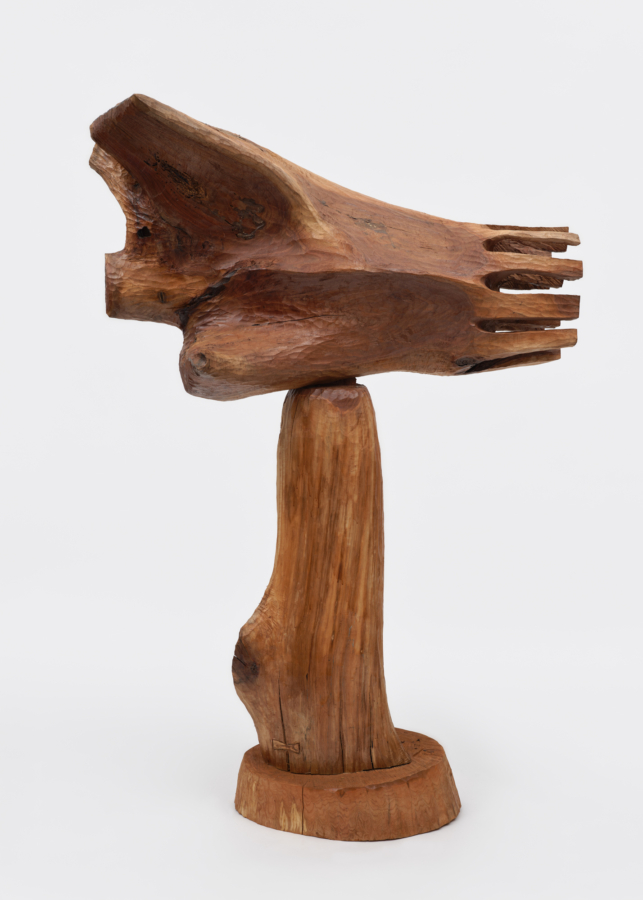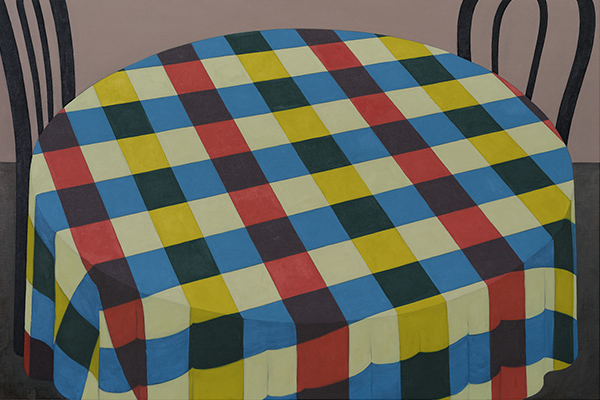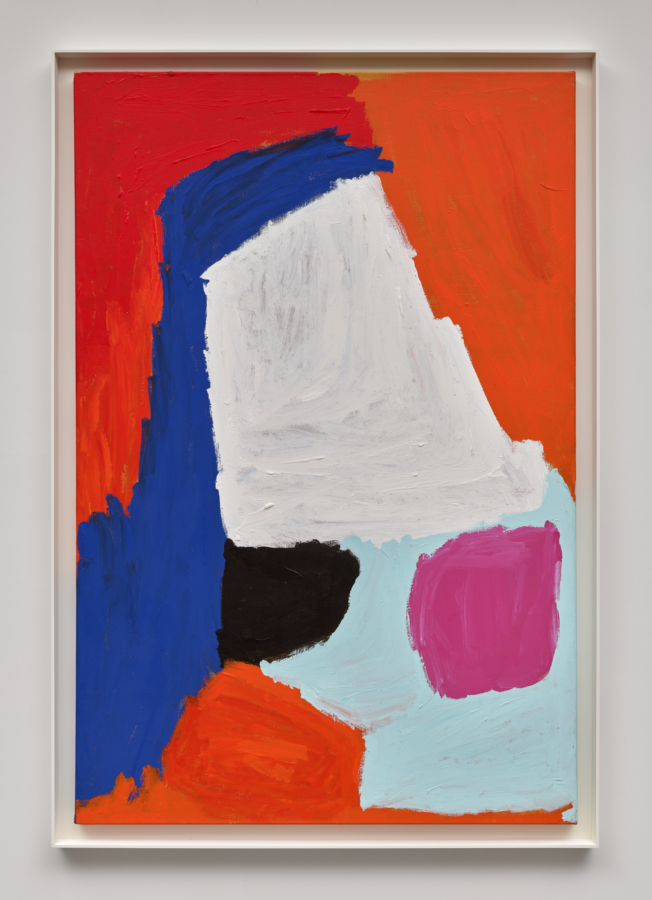2017
Blackwelder, published by Rizzoli International and Gagosian Gallery, 2017
Let’s take a moment to talk about art studio scenography. I am writing this in LA, after all, the land of establishing shots and meticulous mise-en-scène, where that hoary chestnut about a picture being worth a thousand words holds true, if only in the service of narrative expedience. Of course, we have to start with the ramshackle garret, splattered with paint and strewn with brushes, thrown into chaos by the cyclonic force of tragically misunderstood genius. This one plays great to the cheap seats. Where would the myth of the heroic artist be without it? Similarly, think of this cliché’s hipper successor, the antiseptic loft stacked with abstruse objets d’art and littered with the lithe bodies of lounging models. Though hopelessly out of date, both exist in real life even now, unsurprisingly. Artists are no strangers to the studied pose, or to cunning imposture. But even relatively guileless artists, those uninterested in putting on a show, tend to operate studios whose atmospheres are inseparable from their work and their artistic attitudes, despite the fact that these might not yet be ready to be given the Hollywood treatment. I once visited a studio where every object was assiduously arranged by size, down to the liquor bottles in the bar. The work produced therein could best be described as “fussy.” A dear friend of mine keeps a studio chockablock full of miscellaneous crap. His work is slapdash, insouciant, teetering on the brink of internal collapse. Every artist whose work is lumped under the vague moniker “post-Internet” owns at least one sleek, ergonomic chair, as sure as death and taxes.
I’ve been to a lot of studios, and I’ve come to have a pretty good idea of what I can expect. But the first thing I saw when I entered the joint studio of Jonas Wood and Shio Kusaka, which is tucked into an industrial Culver City side street called Blackwelder, was just about the last thing I would have thought I’d see: other people’s art. Lots of it, in fact. The office, which acts as the studio entrance, the bathrooms, and even some of the painting storage racks are packed with the work of the couple’s friends, most of them from Los Angeles. In the corner of Wood’s section of the studio, hung above a tasteful midcentury sofa, there is even a modest work by Alexander Calder that he inherited from his grandfather, who was a serious amateur painter and a periodic art collector. The presence of so much other art, hung on the walls of the one space that is supposed to be the undisputed bastion of an artist’s singular creative endeavor (or in this case, binary creative endeavor) struck me as both generous and touchingly domestic. As I got to know Wood and Kusaka and their work a little better, I quickly realized that this dual sense of openness and intimacy is central to their lives as artists, parents, and human beings. Upon arriving at the studio, I was offered a coffee, which was served in one of Kusaka’s delicate mugs.
The Blackwelder studio is the second studio that Wood and Kusaka have shared. The first, they tell me, didn’t work out very well—it skidded to a halt just short of irrevocable interpersonal disaster. Now, however, they seem to have worked out the kinks: this studio is a thriving artistic ecosystem, where everything seems intimately intertwined. So much so, in fact, that even they have trouble picking apart the strands of their work. Noticing how, for instance, Wood has a tendency to render body hair and the leaves of certain plants in his paintings using staccato dashes reminiscent of Japanese boro stitching, and that Kusaka will occasionally use the same jittery pattern on the surface of her pots, I inquired as to who had started using the motif first. Both of them professed ignorance.
Not all of the overlapping aspects of their work arise quite as organically as this unconscious pattern swapping, but the sense that Wood and Kusaka draw a tight circle around the world that they inhabit—both artistically and otherwise—is clear. In addition to painting his wife’s pots, Wood is fond of painting the interior of his home and the homes of friends, family, and prominent collectors of his work. When the wider world does creep in, it is almost exclusively in the form of sports broadcasts, which he follows with avidity on a flat screen in the studio, or sports trading cards from his youth. Kusaka, for her part, makes vessels that are, first and foremost, designed with their possible domestic use in mind—even her most seemingly decorative works are glazed on the inside in such a way that they can be used to hold water, say, or a potted plant. Some of her most recent works, faux-Grecian urns with whimsical dinosaur motifs, arose out of her children’s love of a series of educational storybooks featuring these ancient reptiles, as well as Jonas’s charmingly off-kilter series of drawings of ancient vessels from the collection of the Metropolitan Museum of Art in New York, assembled in his book A History of the Met: Volume 1 (2010). One could say that Wood and Kusaka are parochial, perhaps, but in a manner that evades the commonly pejorative connotation of the word. They have succeeded in elegantly marrying their art and their lives, and in making their small world seem somehow expansive.
With this in mind, it should be unsurprising that both Wood and Kusaka came to their respective artistic endeavors at least in part through the influence of their families. This could, of course, be said of many artists, but it is often the case that families are portrayed as catalyzing artistic careers through negative influence. The shopworn story of artistic rebellion against the tyrannical rigidity of parental authority might even be as hackneyed as that of the suffering soul in the garret. Both make excellent myths, and both reek of Freud. However, in Wood and Kusaka’s case, family influence seems to have been a largely positive affair. I get the sense that both of them, in their own ways, feel that they are continuing a family lineage.
Kusaka, for her part, comes from a family with ties to traditional Japanese arts and ceremonial practices. Her step-grandfather was a calligraphy teacher, and her grandmother was a teacher of the intricate, meditative art of the tea ceremony. On one of my visits to the Blackwelder studio, she recalled her first experiences sitting with her grandmother for a ceremony, when she was perhaps five. Though the event’s endless litany of finicky particulars proved boring, the way in which she was asked to examine each of the utensils involved in the tea’s preparation with almost comedic reverence and intensity left an impression. In the simple act of attention given to objects that would normally be glossed over with the eye, Kusaka was introduced to what strikes me as a quintessentially Japanese appreciation of humble, utilitarian things, which grows out of the belief that all of life should be structured as an aesthetic experience. Hence, as I have mentioned previously, Kusaka’s requirement that all of the works she makes, no matter how seemingly decorative or sculptural, have the potential for use.
But of course, her vessels nevertheless retain a foothold in that most vaunted realm of the inutile, art. Kusaka glazes most of her vessels with a combination of idiosyncratic takes on traditional Japanese motifs from textile design (such as the boro stitching mentioned previously and the iconic radiating seigaiha pattern) and gridded or netlike patterns that spring from her engagement with American Minimalism, particularly the paintings of Agnes Martin. Like Martin, whose rigorous, muted canvases deftly manage to sidestep the chilly austerity of works by peers such as Donald Judd or Dan Flavin in order to speak in the hushed tones of the spiritual, Kusaka deploys pattern in many of her works in a manner that suggests something more is at play than simple adornment. She pays a calligrapher’s attention to the quality of her lines and their attendant emotional charge, be they hard-edged and surefooted or tremulous and watered-down, and the grids and nets that crisscross many of her more minimal vessels are never perfect but appear broken, wonky, or ill-fitting. A connection to the concept of wabi-sabi, the preeminent aesthetic lodestone of historical Japanese culture, which is rooted in the valorization of the imperfect, the transient, and the incomplete, is clear in these works, and they point, obliquely, to the heavy Japanese influence on the aesthetics of avant-garde American art of the 1950s, ’60s, and ’70s. These works braid together the strands of her familial and artistic heritages, but recent pieces, including the aforementioned dinosaur-themed urns as well as a collection of Pop-inflected pots designed to evoke a variety of different fruits and vessels made to resemble the basketballs that show up frequently in her husband’s sports-themed paintings, point toward her future, both as a mother actively engaged in the imaginative lives of her children, and as an artist whose works are playfully pushing the boundaries of an ancient craft.
Wood, in addition to growing up with an art-making and art-collecting grandfather, was also the son of an architect father and a mother who taught, directed, and acted in theater. This creatively stimulating family environment was formative in innumerable ways, but perhaps the most apparent and lasting influence on Wood’s work comes from the affection that his family has for the architectural and aesthetic atmosphere of midcentury American modernism. This affinity took physical form in the modernist house that his grandfather built for himself in upstate New York, and was continued through his father’s love of the work of Rudolph Schindler and Richard Neutra, making it no surprise that Wood and his family would end up in the city of cantilevered roofs and Case Study houses, which served as both proving ground and laboratory for a pantheon of domestic architectural visionaries of the modernist movement. Some of the works of these heavyweights appear in Wood’s paintings, such as Schindler Apts (2013), which was painted from a photograph taken on an architectural sightseeing excursion with his father; but the strongest sense of midcentury modernist influence on his works can be felt obliquely, through pattern and, oddly, plant life.
Though he is ostensibly a representational painter, Wood, like his wife, has an avid interest in patterning, to the point where it occasionally feels that his subject matter may in fact be almost an excuse for the deployment of a cacophonous chorus of grids, herringbones, plaids, floral prints, and other eye-popping designs. In this, he can be (and has been) compared to such nineteenth-century painters as Vincent van Gogh or Édouard Vuillard, who similarly smuggled abstract flights of fancy into traditional genre scenes. However, unlike these and other painters of their ilk, Wood creates passages of abstraction that are substantially less expressive, less painterly. Instead, they have a riotous, graphic quality that recalls Formica countertops and funky couch upholstery, Googie design and Sol LeWitt wall drawings. They inject optical drama into otherwise staid scenes, causing fractures and disjunctions that mirror the manner in which Wood often breaks up space into disorienting, Hockneyesque shards; the cumulative effect is both playful and discomfiting.
Within the kaleidoscopic world of Wood’s paintings, there is also a profusion of plants. He paints them obsessively, and they show up in his paintings more than any other single motif, whether they are populating a landscape, livening up an interior or a still life, or simply being considered on their own. These plants, which have such folksy monikers as spider plant, Swiss cheese plant, and, a personal favorite, mother-in-law’s tongue, have pleasingly shaped leaves and are marked with beguiling patterns, making them perfect fodder for Wood’s brush. But they also, not incidentally, are plants that, with the introduction of reliable climate control, made their way from tropical climates into the living rooms of stylish American homes in the 1940s and ’50s and became indispensable to the look of modernist decor. Taken together with his evocative use of patterning, these plants embellish the anachronistic ambiance that bleeds in around the edges of even some of Wood’s most contemporary subjects, lending his work a sense that it arises from the intersection of personal experience and family heritage as much as it does from the exploration and expansion of the art historical traditions of genre painting and Pop art.
If Wood’s and Kusaka’s work can be said to flow from the fonts of their individual lineages, then the Blackwelder studio is the pool where they run together. It is this interpersonal and intergenerational commingling that makes the place feel so unique, and that makes the work produced therein appear to arise so organically, as a natural outgrowth of two lives lived in tandem, distinct yet inextricable. This model suggests that Wood and Kusaka have concluded that the best way to live as artists is by tending their own gardens, and occasionally inviting the world to come by and see.



